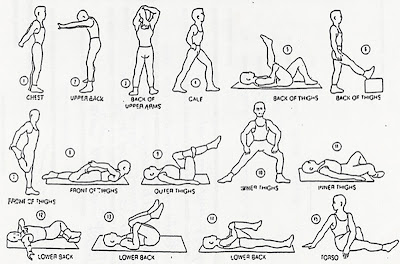Fall, on the other hand, is a great time to start a
fitness program because
"'you're going to create good habits for the holiday season and the
upcoming winter months.
Here are 10 ways to start making the most of the season. And who knows? This
year, you might be in great shape before that New Year's Eve party rolls
around.
1. Take advantage of the weather. Fall can be a treat for
the senses: the crisp air, apple picking, pumpkin carving, a gorgeous canopy of
fall foliage, and the crunch of leaves underfoot. These months are a great time
to exercise outdoors and enjoy cooler temperatures.Discover park trails and take in some new scenery, whether you're walking,
biking, or in-line skating..
In places where snow falls early, try cross country skiing or snowshoeing.
Or, if you live near the beach, get out and play volleyball, throw the Frisbee
around, or play a vigorous game of fetch with your dog.
If you're near a lake, try kayaking or canoeing, for an excellent whole-body
workout and a great change of pace.
And remember, it doesn't have to seem like exercise to be a great
workout.
"Raking leaves or doing some fall outdoor yard work is a great way to
get the heart pumping, and it's great calorie-burning,"
2. Think outside the box. Always wanted to learn to tap
dance? Attempt to box? Master the jump rope? Ask any schoolchild: Fall is a
great time to learn something new.
Many classes at gyms and elsewhere get started in the fall, so look around
and see if something intrigues you.
Fall is the perfect time to gain new physical skills.because
you burn fewer calories when you begin a new activity (thanks to the learning
curve). If you learn something new now, by next summer, you'll have mastered
the skill -- and you'll burn more calories doing it, just in time for swimsuit
season.
3. Be an active TV watcher. Many people get geared up for
fall premieres of their favorite television showsIf you're
going to sit down and watch hours of TV, get moving," she suggests.
"Make a date with exercise and TV."
While you watch, you can walk or run in place, do standing lunges, do tricep
dips off the couch, or lift weights. During commercials, do push-ups or
sit-ups. In a one-hour show, you probably have close to 20 minutes worth of
commercial interruption.
4. Integrate exercise into your life. You already know the
obvious suggestions: park farther away from your destination; take stairs
instead of elevators; take a walk during your lunch break. Here are a few that
are less obvious:
If you're spending the afternoon taking kids to soccer practice, instead of
reading a book or visiting with another parent, "why not walk around the
outside of the field while they practice?", Or (if you
feel comfortable) warm up and cool down with the kids."Or try "walking meetings," like those Price and his colleagues at
Biomechanics often hold. '"We go for a walk, we brainstorm, and we figure
out who's going to take what responsibilities,"veryone feels better for
doing it.You can even get moving while you get motivated -- for fitness or other
life goals. '"Get some inspirational music or find a motivational talk and
download it to your iPod," . Walk while you listen for 30
minutes..
5. Rejuvenate yourself. Fall is the time to rejuvenate
body, mind and spirit, says Durkin. Get a
massage after your run. Learn to
meditate. Take an art class. Treat yourself not just with exercise but other
activities that promote wellness, so you can feel good physically,
mentally, emotionally, and spiritually.
6. Remember the 30-day rule. "'It takes about four
weeks for the body to adapt to lifestyle changes, That's why
people who give up on their fitness programs tend to do so within the first 30
days.
So, when the alarm goes off in the morning and it's darker and colder, don't
roll over and hit the snooze button.
"Try to stick with a program for a month," "After a
month, behavior patterns will have adapted and it will be much easier to stick
with it after that."
7. Strive for the 3 CS calls commitment,
convenience, and consistency "the three Cs", and having all three
will lead to a successful fitness program.
First, exercise takes
commitment. When a client complains to
Freytag about a lack of time, "Tell me something I haven't
heard before. We're all busy; that's just part of our live

You have to start planning exercise, just like you do everything
else," like meetings, dinners, and getting kids to lessons and practice,
she says. "Put in on the calendar, because later always turns into
never."
Convenience means choosing a gym that's close by, or an activity
you can do at home, or a time when you're not likely to be interrupted.
Finally, there's
consistency. "I'd rather see a brand-new
client work out for 10 minutes a day rather than one hour every month,
8.
Deal with darkness. The best way to enjoy fall is to
exercise outdoors. But it is getting darker earlier, and staying dark later in
the morning, so be smart and safe.
"Just because it's 6 p.m. (or a.m.) and dark doesn't mean you can't work
out," . If walking or running outdoors, "wear a
reflective vest and carry a flashlight."
When cycling, affix a light to your helmet or bike.
If possible, use trails or a local school track to avoid vehicle traffic.
Try to work out at the same time every day, so drivers get used to seeing
you.
9. Dress in layers. When exercising outside, layer your
clothing. Before your body warms up, you may feel chilled, but once the blood
gets pumping, you'll feel overdressed.
These days, there's no lack of great weather gear.
clothing with wicking, often called "DriFit."' This fabric
wicks moisture away from your
skin so you're not exercising with wet fabric
hanging on you.
"The inner layer should be a
moisture-wicking fabric, so it wicks away sweat and you're not chilled. The
second layer should be a warmth layer, and the third layer should be a
protective layer (like a windbreaker or rain slicker, depending on the
weather)."
"And don't forget the sunglasses," she warns. UV protection is
important year round. Fall sun can be blinding at certain times of the day.
10. Find your motivation. "People are motivated by
different things," It's important to first discover what your
individual goals are, whether it's
losing weight, strengthening and toning, or
preparing for a race or event
But goals aren't enough to get you there; you have to be motivated by the
day-to-day workouts, he says. So choose something you'll enjoy doing and will
be likely to keep up, whether it's walking or hiking with a friend, working
with a trainer, or taking part in a "boot camp" class.
Creating a challenge for yourself will motivate you, as will encouragement
and accountability, "You want to know when you're doing a good
job, and when you're not,"
Remember too, that anything worth having takes work.








































